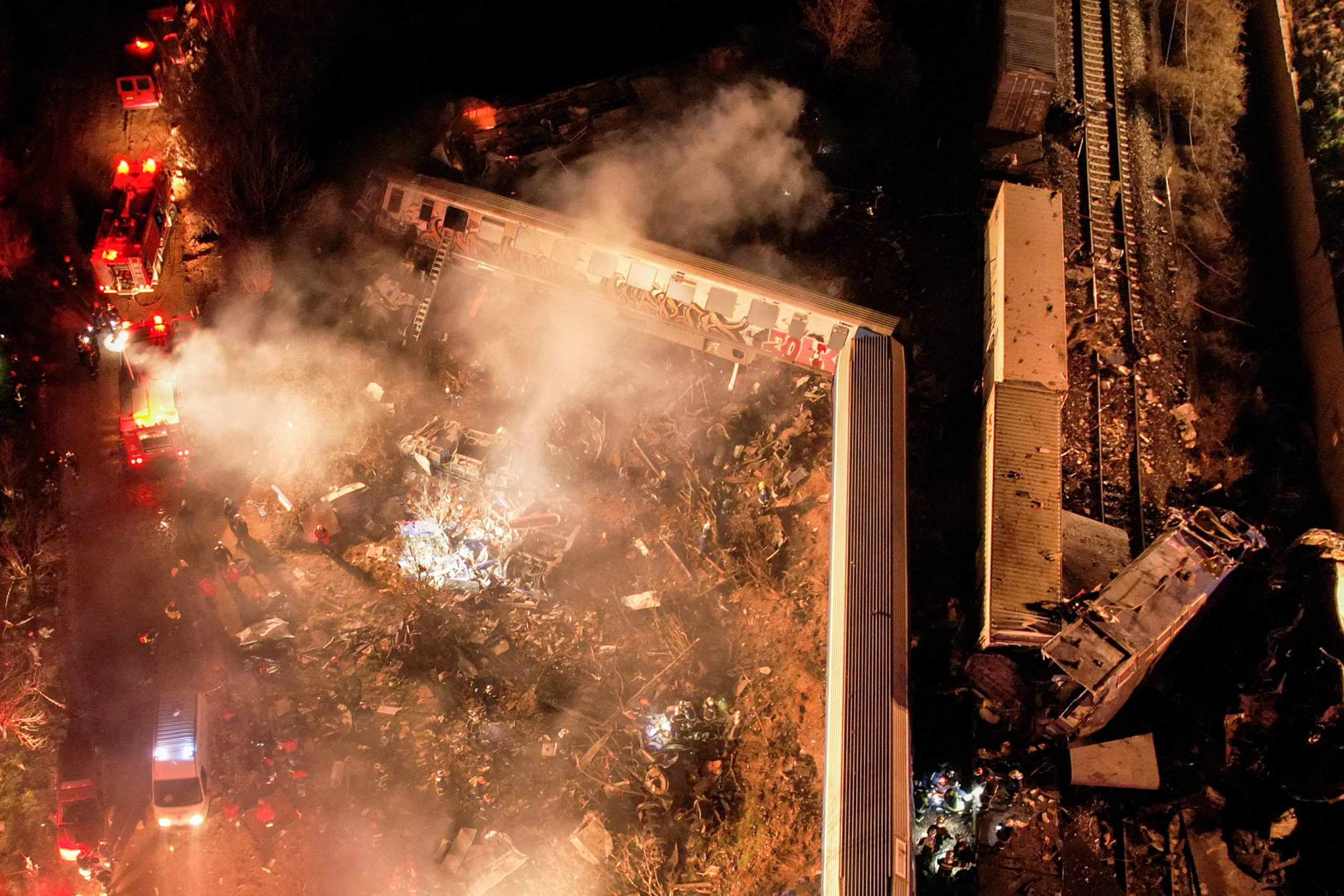
[elfsight_social_share_buttons id=”1″]
At least 36 people were killed when a Greek passenger train collided head-on with a freight train late on Tuesday, derailing carriages which then burst into flames in the country’s deadliest rail crash in living memory.
Many of the victims were thought to be university students returning home after a long holiday weekend and officials said the death toll was expected to rise further, as temperatures in one carriage had risen to 1,300 Celsius after it caught fire.
Authorities are working to establish how the high-speed passenger train collided with another carrying shipping containers, coming in the opposite direction and on the same track at speeds thought to be up to 100 miles per hour.
“Everything in this tragedy points unfortunately, mainly to human error,” Greek Prime Minister Kyriakos Mitsotakis said in a televised address on Wednesday.
Passengers described a “nightmarish” crash which shattered their train just before midnight near the central town of Larissa, some 200 miles north of Athens. It was headed to the northern city of Thessaloniki, from the Greek capital.
Many kicked through windows to escape the inferno, others were flung up to 40 metres on impact.
“There was panic … the fire was immediate, as we were turning over we were being burned, fire was right and left,” said Stergios Minenis, a 28-year-old who jumped to safety.
“Windows were being smashed and people were screaming … One of the windows caved in from the impact of iron from the other train,” another passenger, who escaped from the fifth carriage, told Skai TV.
A station master was arrested as investigators tried to work out why the two trains had been on the same track “for many kilometres”, while the country’s transport minister resigned.
As rescuers scoured the smouldering, mangled mass of steel in the morning, cranes lifted window-less carriages.
Fire brigade spokesman Vassilis Varthakogiannis said the temperatures in the first carriage made it hard to identify those trapped inside or say how many died.
“The confirmed number of dead is 36 but based on these facts, and the findings from the scene of the tragedy, the number is expected to be greater.”
Flags flew at half-staff in Athens, as well as in Brussels, in a tribute to the victims of the crash, as the government declared three days of national mourning.
“It’s an unthinkable tragedy. Our thoughts today are with the relatives of the victims,” Mitsotakis, the prime minister, said at the site of the crash, looking shattered.
In later statements, he said he had accepted the resignations of senior officials in rail operator OSE and its subsidiary ERGOSE. In Athens, around 1,000 people protested outside the offices of Hellenic Train, another branch of the rail network, where some hurled stones at windows.
Police dispersed them with teargas.
TEARS, ANGER
In Larissa, where many victims of the crash had been taken, Nikos Makris sat on the pavement outside the hospital. His wife’s sister was travelling in one of the first two carriages.
“She is missing. We have been waiting here since 2 a.m.,” he told Reuters. “Now we are waiting to do a DNA test. We will be lucky to have a body to bury,” he said.
Others were angry. The relative of one victim shouted: “Some bastard has to pay for this.”
Transport Minister Kostas Karamanlis submitted his resignation, saying he was taking responsibility for the state’s “long-standing failures” to fix a railway system he said was not fit for the 21st century.
The local station master, in charge of signalling, has been charged with causing mass deaths through negligence and causing grievous bodily harm through negligence, a police official said.
The 59-year-old man denied any responsibility, attributing the accident to a possible technical failure, the official said.
Yiannis Ditsas, head of the Greek railway workers union, told Skai TV that automatic signalling at the site of the crash had not been working.
There was no immediate official comment on this.
‘MUM, I’M HURT’
The passenger train was carrying 342 travellers and 10 crew, with two crew on the cargo train, Hellenic Train data showed.
Sixty-six of those injured were hospitalised, six of whom were in intensive care, a fire brigade official said.
Survivors who did not need to be hospitalised were evacuated to Thessaloniki, where one woman ran to embrace her daughter as she disembarked from a bus.
“Mum don’t, I’m hurt,” the daughter said.
Another woman, who was waiting too, said her child was not picking up the phone.
Greece sold railway operator TRAINOSE to Italy’s Ferrovie dello Stato Italiane in 2017 as part of its international bailout programme, expecting hundreds of millions of euros to be invested in rail infrastructure in the coming years.
The Italian division maintained responsibility for passenger and freight, while the Greek state-controlled OSE over infrastructure.
Copyright 2023 Thomson/Reuters
